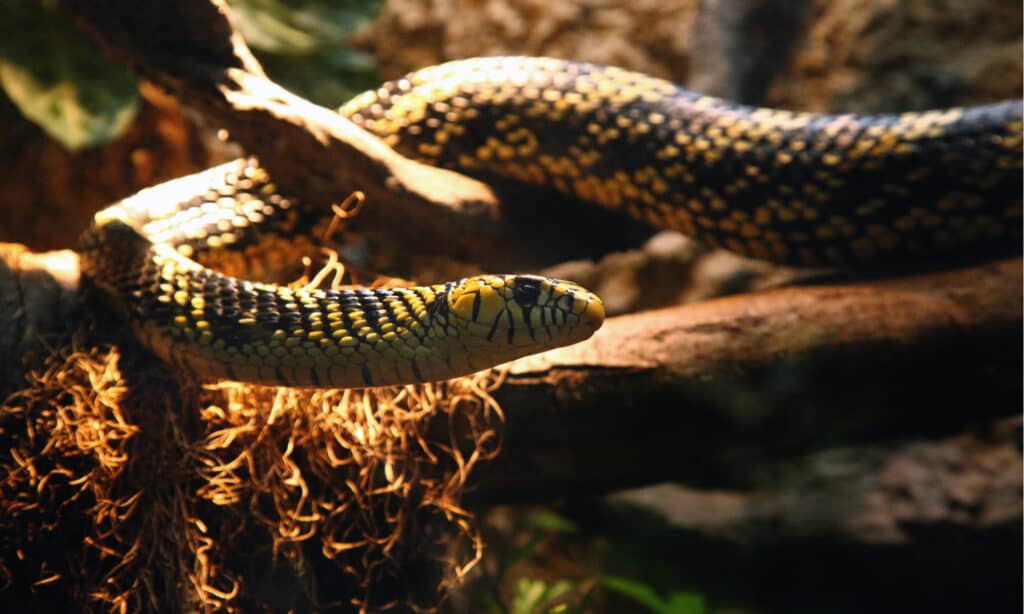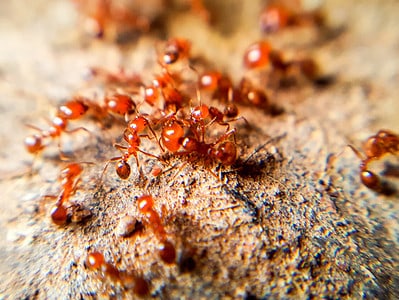Tiger snake
Notechis Scutatus
Tiger Snakes can spend nine minutes underwater without returning to the surface to breathe
Advertisement
Tiger snake Scientific Classification
- Kingdom
- Animalia
- Phylum
- Chordata
- Class
- Reptilia
- Order
- Squamata
- Family
- Elapidae
- Genus
- Notechis
- Scientific Name
- Notechis Scutatus
Read our Complete Guide to Classification of Animals.
Tiger snake Conservation Status
Tiger snake Facts
- Prey
- Frogs, birds, lizards, insects and bats
- Main Prey
- frogs and tadpoles
- Name Of Young
- Snakelets
- Group Behavior
- Solitary
- Fun Fact
- Tiger Snakes can spend nine minutes underwater without returning to the surface to breathe
- Estimated Population Size
- Tiger snakes are widespread, there is not estimate of the population size
- Biggest Threat
- Larger species of snakes and birds
- Most Distinctive Feature
- Their scales comes in a variety of colors
- Distinctive Feature
- Stripe patterns
- Other Name(s)
- Elapid snake
- Gestation Period
- 112 days
- Age Of Independence
- Tiger snakes become independent after birth
- Litter Size
- 15-30
- Habitat
- Creeks, rivers and swamps
- Diet
- Carnivore
- Lifestyle
- Solitary
- Favorite Food
- Frogs and tadpoles
- Origin
- Australia
Tiger snake Physical Characteristics
- Color
- Brown
- Yellow
- Black
- Orange
- Olive
- Skin Type
- Scales
- Lifespan
- 10-15 years
- Weight
- 0.8-2.9 pounds
- Length
- 3,9 feet
- Age of Sexual Maturity
- 4-5 years
- Venomous
- Yes
- Aggression
- Low
View all of the Tiger snake images!
The venomous tiger snake measures a total length of 3.9 feet and is typically located across the east coast of Australia to the bottom of west Australian coastal islands. Their habitat includes creeks, rivers, and swamps where they will hunt and feed on an abundance of prey. These snakes can generally live for about 10-15 years.
Evolution of the Tiger Snake
Their evolutionary relationships with a number of tiger snakes happened through an increasing rate of climate change and sea-level changes. As a result, over the past 6,000-10,000 years, this snake population has become remote, as their appearance in size and their scales have changed because of different environmental pressures.
These snakes’ adaptions refer to the dark coloration of their skin. During their growing season, which takes place in the late summer, the dark coloration assists them in absorbing heat more quickly. Heat speeds up their metabolism, so they have the energy to digest their food.
Because the tiger snake is a cold-blooded animal, it cannot generate its body temperature internally; these snakes have to keep their bodies warm to maintain bodily function.
Amazing Facts About Tiger Snakes
- Tiger snakes are one of the most feared snakes in Australia.
- They produce potent neurotoxic venom, which kills prey and protects them against predators.
- These snakes are active during the day, making them a diurnal species.
- Tiger snakes can spend nine minutes underwater without returning to the surface to breathe.
- When communicating, they use body movement, hissing noises, and rattle the end of their tail.
Where to Find Tiger Snakes
These snakes live in parts of the Southeastern region of Australia located on Bass Strait and Tasmanian Island and other Southwestern areas, including Alcoa Wellard Wetlands and Herdsman Lake.
During the day, they are usually very active as they explore their environment, usually on the ground and occasionally swimming and climbing trees. However, they will only interact with other snakes when mating season begins, as they prefer to live alone.
Tiger Snake Scientific Name
These snakes are in the Elapidae family and belong to the class Reptilia, meaning that they are venomous, and their fangs are always erect at the front area of the mouth.
Population and Conservation Status
The population of this species is estimated to be high. The IUCN Red List has no concern about this snake becoming extinct anytime soon. However, tiger snakes are confronted with threats that include:
- Larger species of snakes and birds
- Unnecessary killings by humans
- Polluted water
- Soil erosion
- Fires
Appearance and Description

Although this snake displays stripe-like patterns, its scales can also lack any kind of pattern.
©Ixepop/Shutterstock.com
People usually misidentify this type of snake due to the variety of their colors. However, the color of their scaley skin and the patterns displayed will generally depend on their habitat. Although this snake displays stripe-like patterns, its scales can also lack any sort of pattern. In this case, people usually confuse them with the eastern brown snake.
Their upper body can include a range of colors such as:
- Gray
- Olive
- Yellow
- Orange brown
- Black
Types of Tiger Snakes
Initially, researchers found two types of tiger snakes, name the eastern tiger snake and the black tiger snake.
However, recent studies have shown that these two snakes are genetically similar in color, size, and proportion. The black tiger snake is native to the southern regions of Australia, where they have an abundance of hiding places amongst the dry, rocky terrain.
The tiger snake has a wide range of sub-species which include:
- Krefft’s tiger snake: (found in South Australia)
- Tasmanian tiger snake: (found in Tasmania)
- Peninsular tiger snake: (found in the offshore islands of South Australia)
- Chappell tiger snake: (located in Bass Strait Island of Southwestern Australia)
- Western tiger snake: (found in the Southwest area of Western Australia)
- Eastern tiger snake: (found in the Southeastern mainland of Australia)
Venom: How Dangerous Are Tiger Snakes?
This snake’s venom contains high quantities of Presynaptic neurotoxins, procoagulants, and myotoxins. As a result, doctors who treat people with this type of snake bite need to administer a double dose of antivenom. In addition, the venom is so potent it causes damage to parts of the body and death if not treated in a couple of hours.
It’s vital that you do not wash the infected area; instead, firmly place a bandage over the bite and keep it secure in a splint to prevent the venom from spreading. In addition, keep the patient calm and still while you wait for emergency services.
- Presynaptic neurotoxins- causes muscle weakness, paralysis, and respiratory failure
- Procoagulants- prevents blood from clotting, resulting in constant bleeding, which can be life-threatening
- Myotoxins- cause necrosis and muscle damage
Tiger Snake Behavior
These snakes are aggressive, especially if they feel threatened. In fact, they have Australia’s second-highest statistics of snakebite-related deaths. To protect itself, the tiger snake will display a defensive posture, keeping its head and neck flat as it raises its body off the ground, ready to attack. In addition, they increase their hissing sounds as a warning to stay away.
If you come across a tiger snake in any of the aforementioned areas in Australia, keep your distance and respect their space.
Tiger Snake Diet
Tiger snakes feed on other animals, meaning they are carnivores. Their primary source of nutrition consists of frogs and tadpoles. If these tasty amphibians are not available, they will hunt for smaller mammals such as bats, fish, birds, lizards, and insects.
These slithering serpents usually hunt for their food during the day, unless the weather is exceptionally warm. In this case, they will wait until the evening when temperatures become cooler. Temperature plays a vital role as they regulate their body temperature, whether it’s a hot or cold day. During cooler temperatures, especially in the winter, they will find shelter to keep warm. Then, they go deep underground by burrowing themselves under trees, where they will hibernate until summer.
When hunting, these snakes strike their prey, before injecting deadly venom into their victim.
Surprisingly, most tiger snakes are blind. They use their incredible sense of smell to catch their prey.
Tiger Snake Reproduction
The breeding season of the tiger snake happens in spring, where mating will peak in the later months of January and February. When the male snake courts a female, he will engage in combat with other males of the same species.
These two males will intertwine their bodies around each other and press down with force on each other’s heads. This interaction will prove which male is the strongest; this snake wins the battle to mate with the female. These combats can usually last up to seven hours!
Female tiger snakes don’t produce eggs. Instead, each of their younglings is born in individual membrane sacs when the mother gives birth between late summer and mid-autumn. After a 112-day gestation period, she will birth between 10 to 64 baby snakes, each measuring 10 cm long.
Related Animals
View all 133 animals that start with TTiger snake FAQs (Frequently Asked Questions)
what is the lifespan of the tiger snake?
The tiger snake’s lifespan is between 10-15 years.
How long can a tiger snake stay underwater?
Tiger snakes can spend nine minutes underwater without returning to the surface to breathe.
Do tiger snakes lay eggs?
Female tiger snakes do not lay eggs but give birth to snakelets.
Thank you for reading! Have some feedback for us? Contact the AZ Animals editorial team.
Sources
- biomedical sciences, Available here: https://biomedicalsciences.unimelb.edu.au/departments/department-of-biochemistry-and-pharmacology/engage/avru/discover/snakes/tiger-snakes-emnotechisem-sp.
- wikipedia, Available here: https://en.wikipedia.org/wiki/Tiger_snake
- venom supplies, Available here: http://www.venomsupplies.com/tiger-snakes/

















